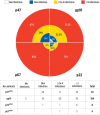Common severe infections in chronic granulomatous disease
- PMID: 25537876
- PMCID: PMC4400412
- DOI: 10.1093/cid/ciu1154
Common severe infections in chronic granulomatous disease
Abstract
Background: Chronic granulomatous disease (CGD) is due to defective nicotinamide adenine dinucleotide phosphate oxidase activity and characterized by recurrent infections with a limited spectrum of bacteria and fungi as well as inflammatory complications. To understand the impact of common severe infections in CGD, we examined the records of 268 patients followed at a single center over 4 decades.
Methods: All patients had confirmed diagnoses of CGD, and genotype was determined where possible. Medical records were excerpted into a standard format. Microbiologic analyses were restricted to Staphylococcus, Burkholderia, Serratia, Nocardia, and Aspergillus.
Results: Aspergillus incidence was estimated at 2.6 cases per 100 patient-years; Burkholderia, 1.06 per 100 patient-years; Nocardia, 0.81 per 100 patient-years; Serratia, 0.98 per 100 patient-years, and severe Staphylococcus infection, 1.44 per 100 patient-years. Lung infection occurred in 87% of patients, whereas liver abscess occurred in 32%. Aspergillus incidence was 55% in the lower superoxide-producing quartiles (quartiles 1 and 2) but only 41% in the higher quartiles (rate ratio, <0.0001). Aspergillus and Serratia were somewhat more common in lower superoxide producing gp91phox deficiency. The median age at death has increased from 15.53 years before 1990 to 28.12 years in the last decade. Fungal infection carried a higher risk of mortality than bacterial infection and was the most common cause of death (55%). Gastrointestinal complications were not associated with either infection or mortality.
Conclusions: Fungal infections remain a major determinant of survival in CGD. X-linked patients generally had more severe disease, and this was generally in those with lower residual superoxide production. Survival in CGD has increased over the years, but infections are still major causes of morbidity and mortality.
Keywords: CGD; bacterial infection; fungal infection; superoxide production; survival.
Published by Oxford University Press on behalf of the Infectious Diseases Society of America 2014. This work is written by (a) US Government employee(s) and is in the public domain in the US.
Figures



Comment in
-
Editorial commentary: severe infections in patients with chronic granulomatous disease.Clin Infect Dis. 2015 Apr 15;60(8):1184-5. doi: 10.1093/cid/ciu1155. Epub 2014 Dec 23. Clin Infect Dis. 2015. PMID: 25537872 No abstract available.
References
-
- Wolach B, Gavrieli R, de Boer M, et al. Chronic granulomatous disease in Israel: clinical, functional and molecular studies of 38 patients. Clin Immunol 2008; 129:103–14. - PubMed
-
- Fattahi F, Badalzadeh M, Sedighipour L, et al. Inheritance pattern and clinical aspects of 93 Iranian patients with chronic granulomatous disease. J Clin Immunol 2011; 31:792–801. - PubMed
Publication types
MeSH terms
Grants and funding
LinkOut - more resources
Full Text Sources
Other Literature Sources
Medical

